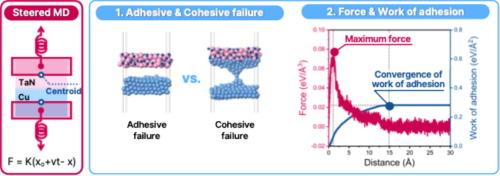利用机器学习原子间势揭示TaN-Cu界面的应变依赖粘附行为
IF 6.9
2区 材料科学
Q2 CHEMISTRY, PHYSICAL
引用次数: 0
摘要
铜(Cu)通常用作半导体中的低电阻互连,但它倾向于扩散到硅(Si)和二氧化硅(SiO2)中。为了缓解这种情况,使用了像氮化钽(TaN)这样的扩散屏障,旨在承受热和电迁移应力。了解应变下TaN/Cu界面的粘附失效是可靠持久性能的关键。在这项研究中,我们利用CHGNet进行定向分子动力学(SMD)模拟,研究了TaN/Cu界面的粘附性。CHGNet是一种机器学习原子间势(MLIP),训练了75000种TaN、Cu和TaN/Cu界面的配置。在−30 %至30 %的双轴应变范围内,对Cu和TaN界面进行了SMD模拟。我们的研究结果表明,最大粘附力取决于特定的TaN和Cu表面,双轴压缩应变通常会增加分离所需的力。这被认为是由于双轴压缩应变引起的TaN/Cu界面原子堆积密度的增加。此外,在各种双轴应变条件下,TaN(11 11)/Cu(11 11)界面的平均粘附最大力为0.074 eV/A3。这是因为TaN(11 11)/Cu(11 11)界面具有较大的晶格错配,导致较大的结构变形,从而增加了初始界面能量并导致更高的最大粘附力。我们相信我们的发现可以指导TaN和Cu之间最佳界面的选择。此外,本研究强调了在类似于操作环境的各种双轴应力条件下寻找稳定界面的方法,为进一步研究扩散屏障的可靠性能提供了有价值的见解。本文章由计算机程序翻译,如有差异,请以英文原文为准。

Unveiling strain-dependent adhesion behavior at TaN-Cu interface using machine learning interatomic potential
Copper (Cu) is commonly used as a low-resistance interconnect in semiconductors, but it tends to diffuse into silicon (Si) and silicon dioxide (SiO2). To mitigate this, diffusion barriers like tantalum nitride (TaN) are used, designed to endure thermal and electromigration stresses. Understanding adhesion failure at the TaN/Cu interface under strain is key for reliable long-lasting performance. In this study, we investigated TaN/Cu interfacial adhesion using steered molecular dynamics (SMD) simulations with CHGNet, a machine learning interatomic potential (MLIP) trained on 75,000 configurations of TaN, Cu, and TaN/Cu interfaces. SMD simulations were performed on various Cu and TaN interfaces under biaxial strains from −30 % to 30 %. Our results show that the maximum adhesion force depends on the specific TaN and Cu surfaces, with biaxial compressive strain generally increasing the force required for detachment. This is supposed to be due to the increase in atomic packing density at the TaN/Cu interface caused by the biaxial compressive strain. Additionally, the TaN(1 1 1)/Cu(1 1 1) interface exhibited a superior average adhesion maximum force of 0.074 eV/A3 compared to other surfaces under various biaxial strain conditions. This is presumed to occur because the TaN(1 1 1)/Cu(1 1 1) interface has a larger lattice mismatch, leading to greater structural deformation, which increases the initial interface energy and results in a higher maximum adhesive force. We believe that our findings can guide the selection of an optimal interface between TaN and Cu. In addition, this study highlights the methodology for finding stable interfaces under various biaxial stress conditions similar to operating environments, offering valuable insights for further research into the reliable performance of diffusion barriers.
求助全文
通过发布文献求助,成功后即可免费获取论文全文。
去求助
来源期刊

Applied Surface Science
工程技术-材料科学:膜
CiteScore
12.50
自引率
7.50%
发文量
3393
审稿时长
67 days
期刊介绍:
Applied Surface Science covers topics contributing to a better understanding of surfaces, interfaces, nanostructures and their applications. The journal is concerned with scientific research on the atomic and molecular level of material properties determined with specific surface analytical techniques and/or computational methods, as well as the processing of such structures.
 求助内容:
求助内容: 应助结果提醒方式:
应助结果提醒方式:


